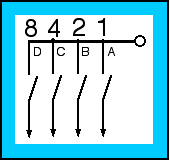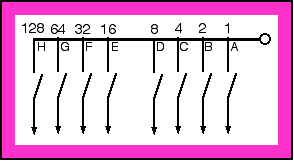


Let's be 'logical' - 2
Boolean Logic.
In the previous Fact Sheet we discussed how we select numbers in electronic data systems.
You may have been wondering how do we get all the numbers from zero to 15 with a mere four switches, and even up to 255 by using a mere eight switches?
Let us start by taking the four-switch arrangement first. In Fig.1 the first switch on the right marked 'A' represents the number 'one'. The next one marked 'B' represents 'two'. The next one, 'C' represents 'four' and the last one 'D' 'eight'. Now the fun begins. Zero is all four switches open. For number one, we close switch A on the right. For the number two we open A and close B instead. To represent the number three, we close both switches A and B and for number four we open A and B and close switch C.

Fig. 1
Now it becomes easy to figure out how this number system works. To represent ten, for example, we close D and B. Switch D gives us eight and B gives us the two. Together that is ten. For 15 we simply close all four switches.
In short, by adding up all the numbers that are represented by the switches we get the wanted number.
Now let us take the system further, beyond the number 15. We said that if we add another set of switches - making it eight - we can switch up to 255.
See Fig. 2. We wish to represent the number 16? Open all switches for a start. (That's number zero.) To express number 16 we close switch E only. For 17 we add A. For 18 we add B instead of A. So it follows that for 31 all ABCD and E are closed. For the number 32 we close F only. For 33 F and A are closed. When all the switches A to H are closed we get the number 255.

Fig. 2
From there it would be feasible to add another set of four switches, making it 12.
In Boolean logic, however, it is customary to double the number. After eight we have 16 switches and the numbers that can be selected goes up at a tremendous rate. Double this again and have 32 where things are becoming almost astronomical. But at this stage let us keep in mind that the switches, as I said in the previous Fact Sheet, are of microscopic size and they open and close at the lightning speed of microseconds. It is for this reason that computers can manage a tremendous amount of data in a short time.
E-mail the editor: peter's email address
Return to Electronics index
Copyright® 1997 - 2003 Peter Schmedding, C.D. Projects,
Canberra, Australia. This page was updated on 14 October 2003.